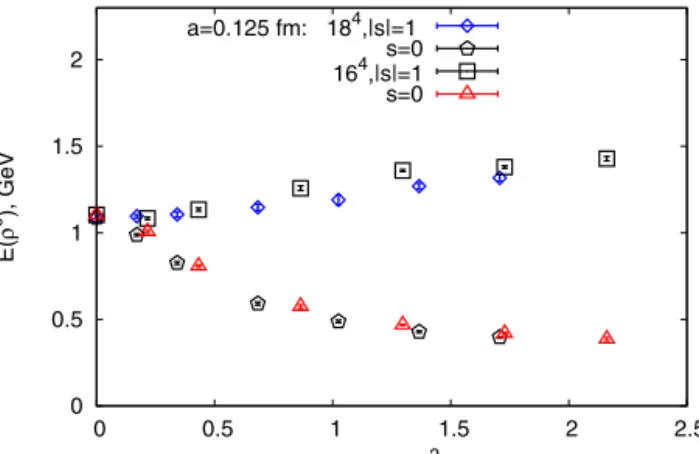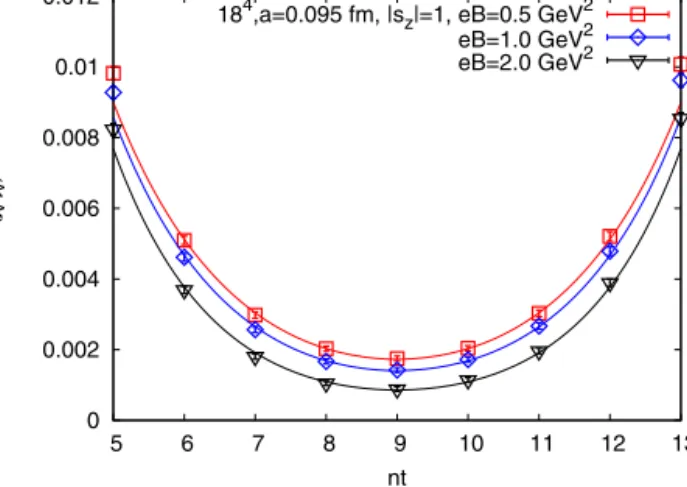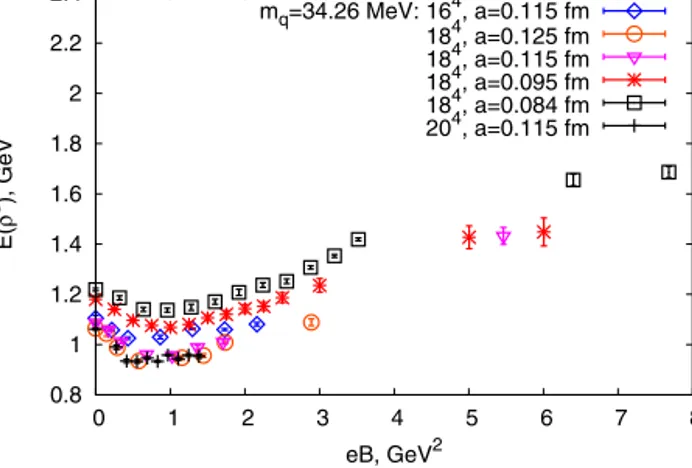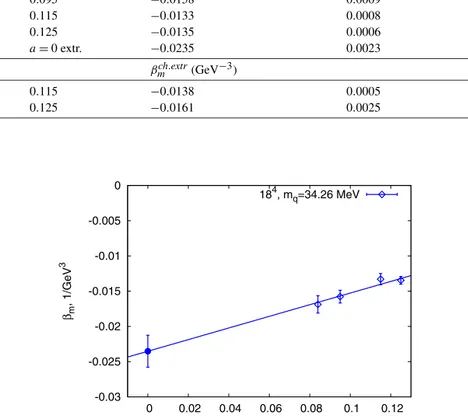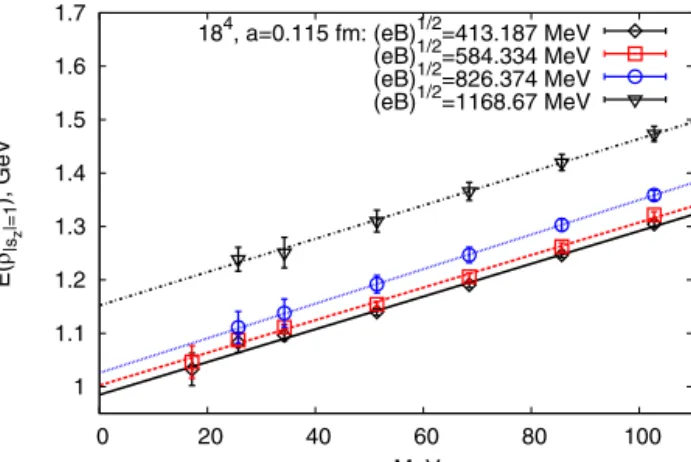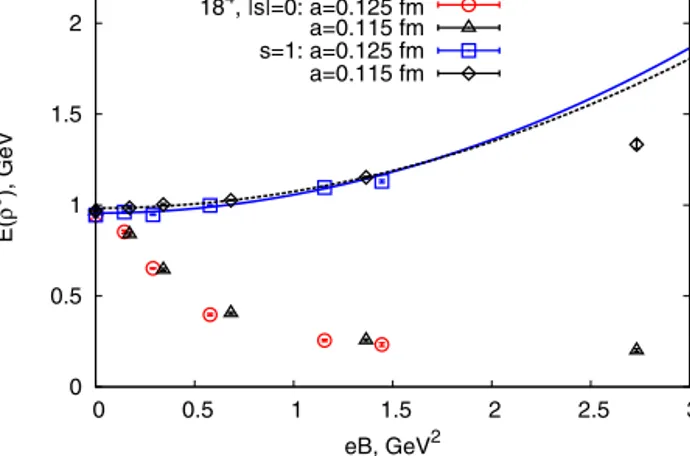Available online atwww.sciencedirect.com
ScienceDirect
Nuclear Physics B 898 (2015) 627–643
www.elsevier.com/locate/nuclphysb
Magnetic polarizabilities of light mesons in SU(3) lattice gauge theory
E.V. Luschevskaya
a,b,c,∗, O.E. Solovjeva
a,c, O.A. Kochetkov
a,d, O.V. Teryaev
e,caStateScientificCenteroftheRussianFederation–InstituteforTheoreticalandExperimentalPhysics, NRC “KurchatovInstitute”,117218Moscow,Russia
bSchoolofBiomedicine,FarEasternFederalUniversity,690950Vladivostok,Russia cNationalResearchNuclearUniversity“MEPhI”(MoscowEngineeringPhysicsInstitute),
Kashirskoehighway31,115409Moscow,Russia
dInstitutfürTheoretischePhysik,UniversitätRegensburg,D-93040Regensburg,Germany eJointInstituteforNuclearResearch,Dubna141980,Russia
Received 17February2015;receivedinrevisedform 16June2015;accepted 12July2015 Availableonline 28July2015
Editor: HermanVerlinde
Abstract
WeinvestigatethegroundstateenergiesofneutralpseudoscalarandvectormesoninSU(3)latticegauge theoryinthestrongabelianmagneticfield.Theenergyofρ0mesonwithzerospinprojectionsz=0 on theaxisoftheexternalmagneticfielddecreases,whiletheenergieswithnon-zerospinssz= −1 and+1 increasewiththefield.Theenergyofπ0mesondecreasesasafunctionofthemagneticfield.Wecalculate themagneticpolarizabilitiesofpseudoscalarandvectormesonsforlatticevolume184.Forρ0withspin
|sz|=1 andπ0mesonthepolarizabilitiesinthecontinuumlimithavebeenevaluated.Wedonotobserve anyevidenceinfavouroftachyonicmodeexistence.
©2015TheAuthors.PublishedbyElsevierB.V.ThisisanopenaccessarticleundertheCCBYlicense (http://creativecommons.org/licenses/by/4.0/).FundedbySCOAP3.
* Correspondingauthor.
E-mailaddresses:luschevskaya@itep.ru(E.V. Luschevskaya),oesolovjeva@gmail.com(O.E. Solovjeva), oleg.kochetkov@physik.uni-r.de(O.A. Kochetkov),teryaev@theor.jinr.ru(O.V. Teryaev).
http://dx.doi.org/10.1016/j.nuclphysb.2015.07.023
0550-3213/©2015TheAuthors.PublishedbyElsevierB.V.ThisisanopenaccessarticleundertheCCBYlicense (http://creativecommons.org/licenses/by/4.0/).FundedbySCOAP3.
1. Introduction
Quantum Chromodynamics in abelian magnetic field of hadron scale is a rich area for explo- ration. The investigation of strongly interacting quark–hadron matter in such field has a funda- mental significance. Today it is possible to create a strong magnetic field of 15m2π∼0.27 GeV2 [1] in terrestrial laboratories (ALICE, RHIC, NICA, FAIR) during non-central heavy ion col- lisions. Our studies aim at revealing the effects that can appear in such experiments. The fun- damental properties of particles related to their internal structure are also very important for understanding these effects.
Let us mention the most famous results concerning QCD physics in the strong magnetic fields. The asymmetry of emitted charged particles [2–4]in non-central collisions of gold ions at RHIC was explained by chiral magnetic effect [4–6]. Many phenomenological studies have been devoted to understanding of QCD phase diagram in the strong magnetic fields. Chiral perturbation theory predicts the decrease of the transition temperature from the confinement to deconfinement phase with increasing abelian magnetic field [7]. External magnetic fields also strengthen the chiral symmetry breaking [8–12]. It was shown in the framework of Nambu–Jona- Lasinio model that QCD vacuum becomes a superconductor in sufficiently strong magnetic field (Bc=m2ρ/e1016Tl) along the direction of the magnetic field [13–17]. The transition to the su- perconducting phase is accompanied by condensation of charged ρmesons. The strong magnetic fields can also change the order of the phase transition from the confinement to deconfinement phase [18–22].
According to the calculations on the lattice with two types of valence quarks in QCD the critical temperature of the confinement–deconfinement phase transition slightly increases in the strong magnetic field [24]. Simulations in Nf =2 +1 theory with dynamical quarks showed that Tcdecreases with increasing magnetic field [25]. This temperature behaviour was confirmed in [23] and now this effect is known as inverse magnetic catalysis. Lattice simulations with dynamical overlap fermions in two-flavour lattice QCD also showed the decrease of the critical temperature of the confinement–deconfinement transition when the field strength grows [26].
Numerical simulations in QCD with Nf =2 and Nf =2 +1 indicate that strongly interacting matter in a large magnetic field posses paramagnetic properties both in the confinement and deconfinement phases [27–29]. Equation of state of quark–gluon plasma was investigated in [30].
Here we continue our previous work where we studied light mesons in SU(2)lattice gauge theory [31]. We extend this analysis to the SU(3)lattice gauge theory which is more physical and calculate the ground state energies of light mesons depending on their spin as a function of the magnetic field value. Our previous results are in a qualitative agreement with the results of this work. We also calculate several hadron characteristics such as the magnetic polarizabilities of light neutral pseudoscalar and vector mesons. The magnetic polarizability is an important physical quantity which reveals the internal structure of a particle in the external magnetic field.
We also made the extrapolation to the zero lattice spacing where it was possible. Our approach is numerically expensive so we do not take into account dynamical quarks.
Several articles are devoted to the study of meson masses in the strong magnetic field. The masses of ρ mesons have been calculated according to the relativistic quark–antiquark model in [32]. Lattice study with dynamical quarks [33] agrees with our data for eB <1 GeV2. Phenomenological study was done in [34]. For the case of non-zero spin our results are in a qualitative agreement with the results of [32–34]. For the zero spin our data agree with these results only for small magnetic fields.
E.V. Luschevskaya et al. / Nuclear Physics B 898 (2015) 627–643 629
2. Details of calculations
For the generation of SU(3)gauge configurations the tadpole improved Lüscher–Weisz action was used
S=βimp
pl
Spl− βimp
20u20
rt
Srt, (1)
where Spl,rt=(1/3) Tr(1 −Upl,rt)is the lattice plaquette (denoted as pl) or 1 ×2 rectangular loop (rt), u0=(W1×1)1/4= (1/3) TrUpl1/4is the tadpole factor, calculated at the zero temperature [35]. This action suppresses ultraviolet dislocations which lead to the appearance of non-physical near zero-modes of Wilson–Dirac operator.
Next, we solve Dirac equation numerically
Dψk=iλkψk, D=γμ(∂μ−iAμ) (2)
and find eigenfunctions ψk and eigenvalues λk for a test quark in the external gauge field Aμ. We find eigenstates of Dirac operator to calculate the correlators. From the correlators we obtain ground state energies. For the calculation of the fermion spectrum we use the Neuberger over- lap operator [36]. This operator allows to investigate the theory in the limit of massless quarks without chiral symmetry breaking and can be written in the following form
Dov=ρ a
1+DW/
DW†DW
. (3)
DW =M−ρ/a is the Wilson–Dirac operator with a negative value of ρ/a, a is the lattice spacing, Mis the Wilson term. Fermion fields obey periodical boundary conditions in space and antiperiodic boundary conditions in time. The sign function
DW/
(DW)†DW=γ5sign(HW), (4)
is calculated using the minmax polynomial approximation, where HW =γ5DW is hermitian Wilson–Dirac operator. We investigate the behaviour of the ground energy states of mesons in the background gauge field, which is a superposition of non-abelian SU(3)gluon field and U (1) abelian uniform magnetic field. Abelian gauge fields interact only with quarks. In our calcula- tions we have neglected the contribution of dynamical quarks. Therefore we add the magnetic field only to the overlap Dirac operator. For this reason we use the following ansatz:
Aμ ij→Aμ ij+ABμδij, (5)
where
ABμ(x)=B
2(x1δμ,2−x2δμ,1). (6)
In order to make this substitution consistent with the fermion boundary conditions one should use the twisted boundary conditions [37]. Magnetic field is directed along zaxis and its value is quantized
qB= 2π k
(aL)2, k∈Z, (7)
where q= −1/3 eis the elementary quark charge.
The quantization condition implies that the magnetic field has a minimal value √
eBmin= 380 MeV for the 184 lattice volume and spacing a =0.125 fm. We are far from saturation regime, where k/(L2)is not small because we use k between 0 and 32. For the inversion of overlap Dirac operator we use Gaussian source (with radius r=1.0 in lattice units in space and time direction) and point receiver (the quark position smoothed with Gaussian profile).
Our simulations have been carried out on symmetrical lattices with the lattice volumes 164, 204, lattice spacing 0.115 fm, 0.125 fm and lattice volume 184, a=0.084 fm, 0.095 fm, 0.105 fm, 0.115 fm, 0.125 fm. We use statistically independent configurations of gluon fields, ∼150 con- figurations for the volume 164, ∼200 and ∼90 configurations for the lattice volumes 184and 204 correspondingly. We consider various bare quark masses in the interval [0.01, 0.06].
3. Observables
We calculate the following observables in the coordinate space and background gauge field A
ψ†(x)O1ψ (x)ψ†(y)O2ψ (y)A, (8)
where O1, O2=γ5, γμ are Dirac gamma matrices, μ, ν =1, . . . , 4 are Lorenz indices, x = (na, nta)and y=(na, nta)are the lattice coordinates. The spatial lattice coordinate n, n∈ 3= {(n1, n2, n3)|ni=0, 1, . . . , N−1}, nt, nt are the numbers of lattice sites in the time di- rection. In the Euclidean space ψ†= ¯ψ. In order to find the observables (8)we calculate the quark propagators in coordinate space. For the M lowest eigenstates massive Dirac propagator is represented by the following sum
D−1(x, y)=
k<M
ψk(x)ψk†(y)
iλk+m . (9)
We use M=50 lowest eigenstates. For the observables (8)the following equation is fulfilled ¯ψO1ψψO¯ 2ψA= −Tr[O1D−1(x, y)O2D−1(y, x)]
+Tr[O1D−1(x, x)]Tr[O2D−1(y, y)]. (10) The first term in (10)is the connected part, the second term is the disconnected part. We have checked that in SU(3)theory without dynamical quarks the disconnected part contribution to correlators is zero. We perform Fourier transformation numerically
(p, t )˜ = 1 N3/2
n∈3
(n, nt)e−ianp (11)
The momenta phas the components pi=2π ki/(aN ), ki= −N/2 +1, . . . , N/2. For particles with zero momentum their energy is equal to its mass E0=m0. As we are interested in the meson ground state energy, we choose p=0. To obtain the masses we expand the correlation function to the exponential series
C(n˜ t)= ψ†(0, nt)O1ψ (0, nt)ψ†(0,0)O2ψ (0,0)A
=
k
0|O1|kk|O2†|0e−ntaEk, (12)
˜
C(nt)=A0e−ntaE0+A1e−ntaE1+ · · ·, (13) A0, A1are constants, E0is the ground state energy, E1is the energy of the first exited state, ais the lattice spacing. From expansion (13)one can see that for a large nt the main contribution to
E.V. Luschevskaya et al. / Nuclear Physics B 898 (2015) 627–643 631
Fig. 1.Theenergyofthegroundstateofthepseudoscalarneutralπ0mesonobtainedfromthecosh fittothecorrelator CPSPSasafunctionofthemagneticfield.Thedataareshownforthebarequarkmassmq=34.26 MeV,latticevolumes 164,204,latticespacings0.115 fmandlatticevolume184,spacings0.105 fm,0.115 fm,0.125 fm.
Fig. 2.Theenergyoftheρ0(sz= ±1)groundstateobtainedfromthecosh fittothecorrelatorCV V dependingonthe magneticfieldvalue.Thedataareshownforthebarequarkmassmq=34.26 MeV,latticevolumes164,204lattice spacing0.115 fmandlatticevolume184,latticespacings0.084 fm,0.095 fm,0.115 fm,0.125 fm.
the correlator comes from the ground state and due to the periodic boundary conditions has the following form
C˜fit(nt)=A0e−ntaE0+A0e−(NT−nt)aE0
=2A0e−NTaE0/2cosh((NT
2 −nt)aE0). (14)
The value of the ground state mass can be obtained by fitting the function (14)to the lattice correlator (12). In order to minimize the errors and exclude the contribution of the exited states we take the values of nt from the interval 6 ≤nt≤NT −6. Masses of the ρmeson is obtained from the correlator (8), where O1, O2=γμ. If O1, O2=γ5we get the pseudoscalar π meson.
In our calculations uand dquarks are mass degenerate.
Fig. 3.Theenergyoftheρ0(sz=0)groundstateobtainedfromthecosh fittothecorrelatorCV V dependingonthe magneticfieldvalue.Thedataareshownforthebarequarkmassmq=34.26MeV,latticevolumes164,204lattice spacing0.115 fmandlatticevolume184,latticespacings0.084 fm,0.095 fm,0.115 fm,0.125 fm.
Fig. 4.Theenergyoftheρ0mesonforthelatticespacing0.125 fm,barequarkmass34.26 MeV,latticevolumes164 and184forvariousspinprojectionsontheaxisofthemagneticfield.Thedataillustratelatticevolumeeffects.
4. The ground state energies of mesons in strong magnetic field
Fig. 1 shows the ground state energy of the neutral pion obtained from the correla- tor CPSPS = ¯ψ (0, nt)γ5ψ (0, nt)ψ (0, ¯ 0)γ5ψ (0, 0). On this plot we present the data for the bare quark mass mq =34.26 MeV, lattice volumes 184, 164 and lattice spacings a = 0.105 fm, 0.115 fm, 0.125 fm. The π0 energy decreases for the all sets of lattice data and slightly depends on the lattice volume and lattice spacing at all values of magnetic field. At large physical volumes the lattice spacing and lattice volume effects are not significant. But for smaller volumes with an increase of the field the lattice effects become more strong, because the wave function of light pion becomes of the order of (or exceeds) the lattice size.
To obtain the energies of neutral vector mesons with various spin projections on the axis of the external magnetic field we use the combinations of the correlators in various spatial dimensions
E.V. Luschevskaya et al. / Nuclear Physics B 898 (2015) 627–643 633
Fig. 5.Thecorrelatorofpseudoscalarcurrentsforthelatticespacing0.095 fm,latticevolume184andbarequarkmass 34.26 MeVforseveralvaluesofthemagneticfield.
Fig. 6.Thecorrelatorofvectorcurrentsalong‘z’directionfornon-zeromagneticfieldandaveragedcorrelatoroverthree spatialdirectionsateB=0 forthelatticespacing0.095 fm,latticevolume184andbarequarkmass34.26 MeVfor severalvaluesofthemagneticfield.
CxxV V = ¯ψ (0, nt)γ1ψ (0, nt)ψ (0,¯ 0)γ1ψ (0,0), (15) CyyV V = ¯ψ (0, nt)γ2ψ (0, nt)ψ (0,¯ 0)γ2ψ (0,0), (16) CzzV V = ¯ψ (0, nt)γ3ψ (0, nt)ψ (0,¯ 0)γ3ψ (0,0). (17) At non-zero magnetic field the mass of ρ0meson with the spin projection sz=0 is obtained from the CzzV V correlator. The combinations of correlators
CV V(sz= ±1)=CxxV V+CyyV V ±i(CV Vxy −CyxV V) (18) give the ground state energies of meson with the spins sz= +1 and sz= −1.
Fig. 2represents the energy of the ρ0with non-zero spin projections on the axis of the external magnetic field. The energy increases with the field for the all sets of lattice data. At |eB|
Fig. 7. Thecombinationsofcorrelatorsobtainedfromformula(18)correspondingtotheenergiesofρmesonwith
|sz|=1 forthelatticespacing0.095 fm,latticevolume184andbarequarkmass34.26 MeVforseveralvaluesofthe magneticfield.
Table 1
Thevaluesofgroundstateenergyoftheπ0meson,itserrorsandχ2/d.o.f.ofcosh fitto thecorrelatorofpseudoscalarcurrentsforthebarequarkmassmq=34.26 MeV,lattice volume184,latticespacinga=0.095 fm andseveralfieldvalues.
eB(GeV2) E(GeV) Error (GeV) χ2/d.o.f.
0 0.596 0.012 0.058
0.5 0.538 0.015 0.092
1.0 0.476 0.001 0.048
2.0 0.408 0.009 0.047
2.5 GeV2the energy grows quadratically and at large magnetic fields it is increasing slower. The terms iCxyV V and iCyxV V in (18)are zero for the case of neutral particles, so the ρ0masses with s= −1 and sz= +1 coincide. This is a manifestation of C-parity. We should note that simple estimates give the following values of magnetic fields corresponding to the lattice spacing cut-off:
2.5 GeV2for a=0.125 fm, 2.9 GeV2for lattice spacing a=0.115 fm and eB∼3.5 GeV2for a=0.105 fm etc.
In Fig. 3we depict the ground state energy which we obtained from the correlator CzzV V for various lattice spacings and volumes. For the small magnetic fields this energy corresponds to the ρ0meson with sz=0. Also we find the real parts of the non-diagonal terms in correlation matrix equal to zero. At large magnetic fields one cannot neglect the mixing between ρ0(sz=0) and π0(s=0)because of the large branching of the decay ρ0→π0γ. In this work our main goal was to calculate the polarizabilities of ρ0, but not to distinguish ρ0and π0, this may be a topic for the following work.
In Fig. 4we show for comparison the energy of ρ0meson at a=0.125 fm for 164and 184 lattices with various spins. This picture illustrates that the lattice volume effects are not large.
To discuss the quality of the fermion correlators we present the relative plots. InFig. 5the correlator of pseudoscalar currents is depicted for several values of the magnetic field for lattice volume 184and lattice spacing 0.095 fm. The solid lines are the fits do these data by formula(14).
The fits describe the data very well at nt6. In Table 1the values of π0energy, its error and
E.V. Luschevskaya et al. / Nuclear Physics B 898 (2015) 627–643 635
Table 2
Thevalues ofgroundstateenergy oftheρ0 meson withspin projections=0 and χ2/d.o.f.ofcoshfitforthebarequarkmassmq=34.26MeV,latticevolume184,lattice spacinga=0.095 fm andseveralfieldvalues.
eB, (GeV2) E(GeV) Error (GeV) χ2/d.o.f.
0 1.179 0.008 0.174
0.5 0.870 0.016 0.209
1.0 0.618 0.010 0.081
2.0 0.439 0.007 0.027
Table 3
Thevaluesofgroundstateenergyoftheρ0mesonwithspinprojectionss= ±1 and χ2/d.o.f.ofcosh fitforthebarequarkmassmq=34.26 MeV,latticevolume184,lattice spacinga=0.095 fm andseveralfieldvalues.
eB, (GeV2) E(GeV) Error (GeV) χ2/d.o.f.
0 1.179 0.008 0.174
0.5 1.210 0.011 0.227
1.0 1.294 0.018 0.503
2.0 1.495 0.035 1.145
χ2/d.o.f. of the fits are shown. In Fig. 6we present the correlator of vector currents along the axis of the external magnetic field for non-zero eB. At zero magnetic field we average the correlator over x, y and zbecause they are equivalent, this diminishes the errors in the determination of ρ0 meson mass. Fig. 7shows the combinations of correlators obtained from formula (18) corresponding to the energies of ρ0meson with |sz|=1 for the lattice spacing 0.095 fm and lattice volume 184. The parameters of the fits are collected in Tables 2 and 3.
In Fig. 8we show the ρ0energy averaged over three spin components E(ρ0) =(E(ρs0
z=0) + E(ρs0
z=−1) +E(ρ0s
z=+1))/3 corresponding to the energy of unpolarized vector meson, we observe it is approximately a constant value. For the magnetic fields eB <2.5 GeV2the meson energy may deviates from a constant value because of the lattice spacing effects. With the diminishing of the lattice spacing the energy of unpolarized meson becomes closer to a constant value, so it confirms the supposition that a mixing between ρ0(sz=0)and π0(s=0)states may be weak at eB <2.5 GeV2.
From the observation of constant energy of unpolarized meson and the behavior of non-zero spin components (Fig. 2) one can draw some conclusions that there is no tachyonic mode for the explored range of the magnetic fields, i.e. the energy of ρ0(s=0)doesn’t turn to zero. We see the lattice volume effects are small and do not change this conclusion at large magnetic fields.
The decrease of the energy may be compensated by higher powers of eB for its values larger than 1 GeV or so. These effects can be preventing, in particular, from energy turning to zero and possible emergence of tachyonic mode. The same will be true also for the energies of all spin states of charged ρmesons [38]. Still, the case of neutral mesons demands further investigation and study of mixing and lattice spacing effects.
Therefore our calculations show that there is the splitting of ground state energy of neutral vector meson in a strong abelian magnetic field which represents an interesting physical effect.
Fig. 8.Theenergyofthegroundstateofunpolarizedvectorneutralρ0mesonobtainedfromthecosh fitstothecorrelators asafunctionofthemagneticfield.Thedataareshownforlatticevolumes164,204latticespacing0.115 fm,lattice volume184,latticespacings0.084 fm,0.095 fm,0.115 fm,0.125 fmandthebarequarkmassmq=34.26MeV.
Fig. 9.Theenergyofthegroundstateofπ0mesonasafunctionofthesquaredmagneticfield.Thedataareshownfor thebarequarkmassmq=34.26 MeV,latticevolumes164,204,latticespacing0.115 fmandlatticevolume184,lattice spacings0.095 fm,0.105 fm,0.115 fm,0.125 fm.
5. Magnetic polarizabilities
The polarizability of meson is an important physical quantity for the understanding of its internal structure. The magnetic polarizability shows how the distribution of fermion currents responds to the external magnetic field. In this section we discuss the magnetic polarizabilities of pseudoscalar π0and vector ρ0mesons.
In Fig. 9we show the ground state energy of pion as a function of squared magnetic field (eB)2for the bare quark mass 34.26 MeV, various lattice volumes and spacings in a large scale at small magnetic fields. We fit the data at (eB)2∈ [0, 0.3 GeV4]by the function
E=E(B=0)−2πβm(eB)2, (19)
E.V. Luschevskaya et al. / Nuclear Physics B 898 (2015) 627–643 637
Fig. 10.Themagneticpolarizabilityofπ0mesonversusthelatticespacingforthelatticevolumes164,184,204and variousbarequarkmass.
Fig. 11.Themagneticpolarizabilityofpseudoscalarneutralmesonπ0versusthebarelatticequarkmassforlattice volume184andvariouslatticespacings.
where we use “natural” units h¯=c=1, but e2=1/137 in Gaussian units. E(B=0)and βmare the parameters which we find from the fit. We choose this interval for the fit because the term
∼(eB)4gives a small contribution to the pion energy at such magnetic fields.
The dashed–dotted line is for the lattice volume 184and lattice spacing a=0.095 fm, the solid lines corresponds to the lattice volumes 164, 204 and lattice spacing a=0.115 fm, the dashed line is for 184and a=0.115 fm and dotted one corresponds to the case of a=0.125 fm.
The polarizabilities obtained for various lattices are summarized in Table 4. We do not observe any functional dependence of the magnetic polarizability on the lattice spacing, the results are presented in Fig. 10. However there is a dependence of the magnetic polarizability on the quark mass. Fig. 11shows that the value of the magnetic polarizability decreases with the quark mass.
The magnetic polarizability (2.14 ±1.22) ·10−4fm3calculated at the lowest quark mass mq= 17.13 MeV and lattice spacing a=0.115 fm agrees with the prediction of the chiral perturbation theory (1.5 ±0.3) ·10−4fm3[39]. The precise determination of β(π0)value requires a careful
Table 4
Thevaluesofmagneticpolarizabilityoftheπ0mesonforthevariousquarkmasses,latticevolumes184and204and variouslatticespacings.
Vlatt mq(MeV) a(fm) βm(GeV−3) Error (GeV−3) χ2/d.o.f.
184 34.26 0.095 0.036 0.004 0.092
184 34.26 0.105 0.037 0.003 0.050
184 34.26 0.115 0.042 0.006 1.034
184 34.26 0.125 0.049 0.002 0.0131
184 25.70 0.115 0.036 0.005 1.105
184 17.13 0.115 0.028 0.016 1.552
204 34.26 0.115 0.046 0.006 2.502
Fig. 12.Theρ0mesonwiththefitsE=E0(B=0)−2πβm|s|=1(eB)2tothedataontheintervaleB∈ [0,1.8GeV2].All thefitscorrespondtothe184lattice,thedashed–dottedisforthelatticespacing0.084 fm,thesolidlinecorrespondsto thea=0.095fm,thedashedoneisforthea=0.115 fm anddottedlinecorrespondstothecaseofa=0.125fm.
study of its dependence on the quark mass, large statistics and lattice volumes and undoubtedly deserves an attention. At mq=17.13 MeV the pion mass is still sufficiently high and equals to 396 MeV.
In Fig. 12in the large scale we depict the energy of the ρ0ground state with non-zero spin depending on the magnetic field for the bare quark mass mq=34.26 MeV, lattice volumes 164, 184, 204 and various lattice spacings. To obtain the magnetic polarizability we fit our data to the function E=E(B=0) −2πβm|s|=1(eB)2 at magnetic fields 0 ≤eB <1.8 GeV2, where the data are well described by quadratic law. E(B=0)and βm|s|=1are the unknown parameters which were found from the fitting procedure. The values of βm|s|=1for the ρ0meson with the spin
|sz| =1, the errors and lattice parameters are summarized in Table 5and shown in Fig. 13.
We see the strong dependence of the results on the lattice spacing so we perform an extrap- olation to the continuum limit. The extrapolation gives the polarizability value βm|s|=1(ρ0) = (−0.0235 ±0.0023)GeV−3for the lattice volume 184and bare quark mass mq=34 MeV. The magnetic polarizability does not depend on the sign of the ρ0spin projection, so it has a scalar nature.
In Fig. 14 the mass of ρ0 meson with zero spin is depicted for the small magnetic fields.
We observe the linear in (eB)2 behaviour only for (eB)2∈ [0, 0.1 GeV4] and get the value
E.V. Luschevskaya et al. / Nuclear Physics B 898 (2015) 627–643 639
Table 5
Thevaluesof magneticpolarizabilityofthevectorρ0 mesonwith non-zerospin forthebarequarkmass mq= 34.26 MeV,latticevolume184andvariouslatticespacings.Thelasttworowscorrespondtothepolarizabilityafter thechiralextrapolation.
Vlatt a(fm) βmmq=34 MeV (GeV−3) Error (GeV−3) χ2/d.o.f.
184 0.084 −0.0169 0.0012 1.235
184 0.095 −0.0158 0.0009 0.730
184 0.115 −0.0133 0.0008 0.754
184 0.125 −0.0135 0.0006 0.832
184 a=0 extr. −0.0235 0.0023 0.561
βmch.extr(GeV−3)
184 0.115 −0.0138 0.0005 2.648
184 0.125 −0.0161 0.0025 23.862
Fig. 13.Themagneticpolarizabilityofρ0mesonanditsextrapolationbyalinearfunctiontozerolatticespacingforthe latticevolume184andbarequarkmassmq=34.26MeV.
βms=0(ρ0) =(0.47 ±0.03)GeV−3 for the lattice 184 and spacing a=0.125 fm. It is approx- imately in 35 times larger and opposite in sign compared to the magnetic polarizability for non-zero spin case βm|s|=1(ρ0) =(−0.0135 ±0.0006)GeV−3. Unfortunately we cannot consider smaller fields to study effects of lattice spacing.
From the sign of the magnetic polarizability we can conclude about the behaviour of the meson wave function depending on its spin and quantum numbers. Since β >0 the magnetic field extends the wave function of ρ0 meson with zero spin. In the case of non-zero spin the magnetic field squeezes it and the magnetic polarizability has a negative value.
The small value of the magnetic polarizability is not surprising, because we have to apply a very strong magnetic field to observe the response of the internal structure of neutral mesons composed of charged quarks having spin.
Fig. 14.Theenergyofthegroundstateofthevectorρ0mesonwithsz=0 dependingonthesquaredmagneticfield value.Thedataareshownforthebarequarkmassmq=34.26 MeV,latticevolumes164,204,latticespacing0.115 fm andlatticevolume184,latticespacings0.095 fm,0.105 fm,0.115 fm,0.125 fm.
Fig. 15.Thegroundstateenergyoftheneutralvectorρmesonspin|sz|=1 forlatticevolume184,latticespacing a=0.115 fm,variousquarkmassesandseveralvaluesofmagneticfields.Theextrapolationwasdonebythefit(20)to thechirallimit.
6. Quark mass extrapolations
In Fig. 15 we show the ρ0 meson with the spin |sz|=1 as a function of quark mass for lattice volume 184, lattice spacing a=0.115 fm and various magnetic fields. The mass of ρ0 meson was calculated for several mq values in the interval mqa∈ [0.01, 0.06]. Calculations at small quark mass requires large statistics are computational expensive, so we carry out the chiral extrapolation. Then we perform a fit by a linear function
mρ=a0+a1mq (20)
and find the coefficient a0 and a1 with errors by χ2 method. Then we extrapolate mρ(mq)to the limit of zero quark mass mq=0, so-called chiral limit. The result of this extrapolation is presented in Fig. 16for the lattice volume 184and lattice spacings a=0.115 fm, 0.125 fm.
E.V. Luschevskaya et al. / Nuclear Physics B 898 (2015) 627–643 641
Fig. 16.Themassdependenceoftheneutralvectorρ0mesonwithvariousspinsonthevalueofexternalmagneticfield forthelatticevolume184andlatticespacingsa=0.115 fm,0.125 fm afterchiralextrapolation.Thesolidcurveisfor thefittothedataat0.125 fmlatticespacingandthedashedcurvecorrespondstothedataat0.115 fm.
The masses of ρ0with zero spin smoothly decrease with magnetic field while the energies with non-zero spin increase with the field value. In Table 5in the last two rows we show the values of magnetic polarizability obtained from the fits to the data after the chiral extrapolation.
The values of βm|s|=1after the extrapolation agree with the values of βm|s|=1obtained for the bare quark mass mq=34 MeV within the errors for a=0.115 fm. For a=0.125 fm the agreement is not so good, because the extrapolation needs rich data.
7. Conclusions
In this work we explore the ground state energies of π0and ρ0mesons. The mass of pseu- doscalar meson diminishes with the magnetic field value. We obtain the magnetic polarizability of π0meson. For the smallest bare quark mass 17 MeV it equals to (0.028 ±0.016)GeV−3for the lattice spacing a=0.115 fm and agrees with the prediction of chiral perturbation theory.
We observe the splitting of ground state energy of the neutral vector ρmeson depending on its spin projection on the axis of the external magnetic field. The energies of ρ0with the spins sz= +1 and sz= −1 coincide and increase with the magnetic field value. The magnetic polarizability at non-zero spin is equal to βm|s|=1(ρ0) =(−0.0235 ±0.0023)GeV−3after extrapolation to zero lattice spacing.
The energy of ρ0with the spin sz=0 decreases with the field value. The magnetic polariz- ability at sz=0 differs at least in sign from the case of non-zero spin |sz| =1. We consider this phenomena to be the result of the anisotropy created by the magnetic field. The coincidence of vector meson energies with spins sz= +1 and sz= −1 is the consequence of C-parity.
We suppose the mixing between π0and ρ0(s=0)states is not strong at eB <2 GeV2, this is the subject for the further detailed investigation.
We do not observe any evidence in favour of tachyonic mode existence.
Acknowledgements
The authors are grateful to FAIR-ITEP supercomputer center where these numerical calcula- tions were performed. This work was carried out with the financial support of Grant of President

